

 The enactment of the Homestead Law in 1862 drew thousands of settlers to the new state of Kansas.
As settlers began fencing their lands to protect crops from the free-roaming cattle and Bison there became a need to define responsibility
should livestock damage crops. In addition, with miles of fences being constructed daily, there arose a need to define a lawful fence.
In Kansas, lawmakers debated the issue and wrote legally binding definitions of proper fencing. When cropland adjoined land used for grazing,
the statute of Kansas at first placed the burden on the landowner to fence out cattle lawfully at large. This determination was based on free range
grazing laws which permitted cattle to graze unrestrained. Although the farmer was responsible for constructing the fence, he was afforded many advantages
provided the fence met established criteria. However, in later years, the responsibility shifted and ranchers became responsible for fencing their
livestock. A requirement to “fence-‘em out” became a requirement to “fence-‘em in.”
The enactment of the Homestead Law in 1862 drew thousands of settlers to the new state of Kansas.
As settlers began fencing their lands to protect crops from the free-roaming cattle and Bison there became a need to define responsibility
should livestock damage crops. In addition, with miles of fences being constructed daily, there arose a need to define a lawful fence.
In Kansas, lawmakers debated the issue and wrote legally binding definitions of proper fencing. When cropland adjoined land used for grazing,
the statute of Kansas at first placed the burden on the landowner to fence out cattle lawfully at large. This determination was based on free range
grazing laws which permitted cattle to graze unrestrained. Although the farmer was responsible for constructing the fence, he was afforded many advantages
provided the fence met established criteria. However, in later years, the responsibility shifted and ranchers became responsible for fencing their
livestock. A requirement to “fence-‘em out” became a requirement to “fence-‘em in.”
From the 1860s until 1890, much of the Great Plains including the Kansas Territory were Open Range public domain lands. Cattle trails went from western Texas northward through Indian territories of Oklahoma into the Kansas cow towns of Abilene, Emporia, and others. There, cattle were loaded onto the railroads for transport and processing for domestic consumption. During the early part of the time, Kansas rangeland was relatively free of fences.
Fence laws varied over the years. The first attempt at establishing legal responsibility was known as common law. Owners and keepers of livestock were responsible for preventing their animals from trespassing on private property. If livestock damaged someone’s property, the stock owner was held liable for damages regardless of condition of his fences.
In 1855, the first Kansas Fence Law was passed by the first Territorial Legislature of Kansas. The law did not reference common law, but stated that fields must be fenced to protect fields from invasion by livestock. The law also defined criteria how a legal fence should be constructed. If the landowner’s fence met the criteria and wayward livestock breached the fence, he was entitled to recover damages. With Kansas being an Open Range territory, this fence-out law seemed the logical choice. The rationale was that it was less expensive to fence small fields of cropland than to fence in large herds on the open prairie.
On February 11, 1859, the Governor and Legislative Assembly of the Territory of Kansas enacted legislation for An Act Regulating Enclosures more strictly defining the Kansas Fence Law of 1855:
Sec 4. If any horse, cattle or other stock shall break into any inclosure, the fence being of the hight[sic] and sufficiency aforesaid, the owner of such animal shall make reparation to the party injured for the true value of the damages he shall sustain, and be allowed to take into possession the animals so trespassing, ad be entitled to keep the same until damages with reasonable charges for keeping and feeding, and all costs of suit be paid, to be recovered before a justice of the peace or in the district court.
If an animal breached a fence, and trespassed upon cultivated or other fenced land, the animal's owner was deemed responsible for the damage. The law further granted possession of the animal to the landowner until such time as he was properly compensated.
Specifications for wood, earth, or hedge fencing were established as early as 1855, but by 1860 the use of smooth wire for fencing created a need for modification to the laws. On February 24, 1860, the Legislative Assembly of the Territory of Kansas passed An Act Legalizing Wire Fence:
Be it enacted by the Governor and Legislative Assembly of the Territory of Kansas:
Section 1. That all fences composed of posts and wire, shall be at least four and a half feet high. The posts shall be of the ordinary size for fencing
purposes, and set in the ground two feet deep, and not over nine feet apart, with holes through the posts, not over fifteen inches apart to admit
three separate strands of number nine fence wire, with rollers and levers, at suitable distances, to strain and hold the wire straight and firm;
and such fence shall be deemed a lawful and sufficient inclosure.
In 1929, the responsibility for animals being at large was reversed. A Kansas Herd Law established a fence-in policy. Penalties were imposed against ranchers who failed to contain their animals. Ranchers were no longer enabled to allow their animals to run at large with immunity from prosecution. The law now favored the farmer, not the rancher. Rather than the landowner being responsible to fence-out animals, ranchers were responsible to fence-in their animals. The days of the free range were coming to a close.
For years after 1929, a few Kansas counties continued to follow the earlier open range fence laws. Common Law, Fence Law, and the Herd Law were still active statutes. This created difficulty in determining responsibility for damages to crops or other property caused by livestock. In 1986, the Kansas Legislature passed Senate Bill #403 adopting the Kansas Herd Law as the uniform law of the state. It states that domestic animals can no longer run at large and must be enclosed by a fence. The law also stipulated that the owner of the livestock must be proven negligent before he can be held responsible for damages caused by trespassing animals.